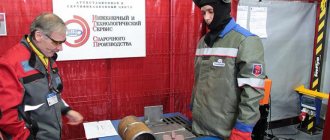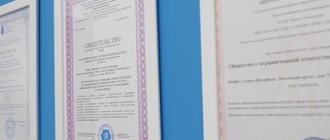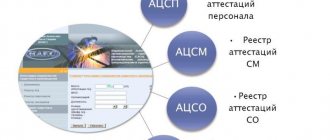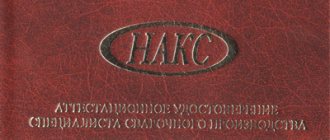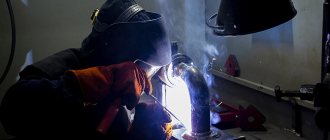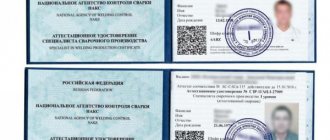Organizations performing high-risk work are required to undergo periodic compliance testing, which results in the issuance of a permit or certificate giving the right to carry out the relevant activity. NAKS certification is a check of the level of training of welders, technology and compliance of the enterprise with current technical standards. In regional centers, personnel involved in welding work can improve their skills.
NAKS is
NAKS is a self-regulatory organization Non-Profit Partnership “National Welding Control Agency”.
NAKS objectives:
- Development of standards, methods and regulations for certification of welding process production.
- Determination of the expert composition of the commission on types and areas of production certification.
- Conducting expert control over newly formed and existing certification centers.
- Development of methodological recommendations, consulting on the functioning of centers
- Accumulation and generalization of domestic and international experience in the field of production certification. Development of proposals for improving the certification system.
- Selection, formation and implementation of technical areas in the Welding Certification System (CAC).
- Implementation of coordination policy in the activities of SASv.
- Preventing the introduction and application of norms, methods, regulations and procedures not reflected in the activities of SASv.
Why is certification needed?
A welder who has passed the NAKS certification is a highly qualified specialist authorized to carry out work in high-risk conditions:
- gas pipeline; pipeline;
- closed space of storage tanks;
- ship's hold;
- a blast furnace or open hearth furnace is not the entire list of objects.
The danger arises from the presence of flammable substances that can cause a fire or explosion.
Certification is carried out so that the specialist remembers his theoretical knowledge, confirms his practical skills, and learns new things in the field of welding.
NAKS certification procedure
The knowledge confirmation course consists of several stages:
- Preparation of necessary documents (the list depends on the level being passed and the specialist’s knowledge):
- application for certification;
- document on special education;
- certificate of training courses in a specialized profession (advanced training, obtaining the next rank);
- confirmation of general experience in the specialty, extract from the work book;
- a few photos;
- confirmation of completion of safety training within Rostechnadzor (copies of protocols);
- passing a medical examination.
- Conducting the first practical exam. If the results are unsatisfactory, the examinee is disqualified from further examination. The next retake will come in a month, during which it is necessary to prepare, undergo additional training and instruction.
- Admission to a general and special exam means that a welder performs a number of practical works, adheres to safety regulations, and confirms knowledge of labor safety standards. A specialist can be certified in several types of welding operations at once.
Who can and should undergo certification
Employees of a hazardous facility (controlled by Rostekhnadzor) at which installation operations are supposed to be carried out or are undergoing must be certified. Specialists, in accordance with the standards, are assigned certain NAKS levels:
The type of certification directly depends on the industry sector.
The expert commission cannot cancel or annul the qualification category of a welding specialist.
Order of conduct
The certification procedure is established in accordance with the current regulatory documents of NAKS, which coordinates the activities of regional centers.
Stages of certification of welders:
- The specialist provides the nearest regional center with a package of documents, including an application, a certificate from the place of work or an extract from the work record book, documents confirming qualifications, as well as a medical certificate of the established form.
- The processing time for the application is 3 days. The candidate is notified of the committee's decision by written notice. According to current legislation, in case of refusal, the center is obliged to indicate the reason.
- The test begins with a practical exam. The candidate receives tasks whose complexity corresponds to the declared category. The connection must be made taking into account all the requirements of the relevant government standards.
- The next stage is the theoretical exam. As with testing practical skills, the complexity and number of questions depends on the declared level. For example, to obtain a first-level certificate, you need to answer 15 questions, and to certify technologists, the number of tasks in the ticket increases to 20.
In case of a negative result, the candidate has the right to try again within 3 months . Re-certification is carried out in the same center.
The period for testing a welder’s knowledge, as a rule, does not exceed 2 weeks. The cost depends on the specific regional center and geographic location. It varies between 28,000-33,000 rubles.
Obtaining NAKS certification
Certification is carried out in all regions of the Russian Federation. Training and examinations are assigned to NACS centers or points. The program must include:
- Study of a set of measures for labor protection and safety in welding production.
- Training in the technology of making welded joints and deposited layers of metal.
- Type of materials for welding, equipment and fixtures.
- Methods for monitoring the quality of a weld.
- Methods for preventing or eliminating defects that have arisen.
Documents based on the results of the inspection
Upon completion of the course, a specialist who has successfully completed the training will be issued:
- NAKS certification certificate. The document is valid throughout the Russian Federation.
- A copy of the protocol on passing the next type of certification (primary, periodic, extraordinary or additional).
- Certificate of preliminary preparation before passing the test.
The data is entered into the NAKS register. If, for any reason, the above documents are lost, you can confirm that the verification has been completed by contacting the EDO NAKS (electronic document management).
IMPORTANT! Welders are allowed only to those types of work that are included in the certification certificate of a welding specialist.
Welders levels
According to the NAKS system, there are four levels of professional training:
. Must have a diploma and rank. Persons who have undergone professional training at courses, schools, or at their place of work are allowed for inspection. The minimum work experience in a specific type of welding varies from 6 to 12 months.
. Must have secondary technical education or higher education, undergo training in advanced training centers. With higher education, work experience is acceptable from 6 months. With an average - 9-36 months.
. Persons with higher technical education in welding. Work experience from 6 to 12 months and level II certification. If there is no such certificate, the work experience must be 18-36 months.
. Persons with higher education in welding production. It is acceptable to not have a higher education diploma in welding if you have academic degrees (doctor, candidate) in technical sciences.
Contents of the certificate
The document reflects:
- Scope of certification for the NAKS category.
- Method (type) of welding.
- Type of welded parts according to NAKS.
- Type (type) of welding seam.
- Group of material to be welded.
- Welding material (type of electrode, wire).
- Part thickness range.
- Minimum product diameter.
- Spatial position of the weld.
- Type (type) of connection.
Validity period of the certificate:
- Welder - 2 years.
- NAKS specialist level 2 (3rd) - 3 years.
- NAKS specialist level 4 - 5 years.
Welding methods
Certification of NAKS equipment is carried out taking into account technologies that can be applied to one or another type. If you are going to take the exam, you should definitely know how to decipher each type of welding. For beginners, here is a translation of some of them:
- MP – mechanized welding using a consumable electrode, carried out in a shielding gas environment.
- RAD – manual welding with a tungsten electrode in an argon environment.
- RD - manual arc welding using a consumable electrode.
- AF – automatic welding carried out using flux.
- P – plasma welding.
- MPS – mechanized welding using flux-cored wire.
- ES – electroslag welding.
- MAWP – mechanized welding using a consumable electrode in an argon environment.
- AMA – automatic welding with a tungsten electrode in an argon environment.
- AADP – automatic welding using a consumable electrode in an argon environment.
- G – gas welding.
What does NAKS take into account during inspections?
In addition to the specialist’s knowledge, workplaces, equipment, types of production, and welding methods are inspected. The latter directly concerns the welder, since control of his knowledge is carried out in accordance with the types of operations that are performed according to the technological process:
Any welding process involves the use of a certain type from the group of welded materials according to NAKS. The list consists of 22 subgroups and includes:
- black metals;
- carbon steels;
- low alloy and alloy steels;
- high alloy steels;
- reinforcing steels for reinforced concrete structures;
- cast iron;
- non-ferrous metals and alloys based on them;
- various polymers and materials not included in the general list.
NAKS groups are designated by letters: letter and number. For example: M11 is a subgroup of high-alloy steels of the austenitic or austenitic-ferritic subclasses.
A welder who has successfully passed the inspection is allowed to work with products and parts classified into the NAKS groups of dangerous technical devices:
- PTO (handling and transport equipment);
- KO (boiler equipment);
- GO (gas equipment);
- NGDO (oil and gas production equipment);
- MO (metallurgical equipment);
- NAKS OKVNP (equipment for chemical, petrochemical, oil refining and fire and explosion hazardous industries);
- GDO (mining equipment);
- OTOG (equipment for transportation of dangerous goods);
- SK (building structures);
- KSM (steel bridge structures).
A complete list of groups of dangerous technical devices NAKS is given in the regulatory documents of the self-regulatory organization.
In this article:
It states that they have the right to conduct preparatory courses and certification, study welding equipment for compliance with specifications, and check welded joints. Now there are accredited centers with a license that have the right to carry out inspections and issue certificates.
The need for certification arises at enterprises and industries operating under the Gosgortekhnadzor of Russia, where the following is used:
- transportation mechanisms for moving dangerous goods;
- lifting and transport devices;
- building construction;
- gas equipment;
- mining;
- boiler room;
- metallurgical;
- equipment for chemical, explosive, petrochemical production.
NACS goals
The audit covers a fairly wide range of issues:
- Welding process technology. The goal is to confirm the technical and technological capabilities of the enterprise to carry out the declared work. Certification is a mandatory procedure for a company operating in the Customer’s territory. After successfully passing the test, a certificate is issued confirming the company’s ability to use the declared welding technology. The document is valid for 4 years.
- Equipment and materials. The goal is to check the compliance of the technical condition of the equipment, properties and technical characteristics of welding materials with the data specified in the accompanying documentation. If the certification commission makes a positive decision, a NAKS certificate is issued:
- valid for 3 years for mass-produced materials;
- 1 year - for a pilot batch.
Such checks are necessary, since the NAKS technical device groups include various equipment that require certain operating methods. You will need:
- appropriate training of specialists; technical serviceability of the welding machine;
- compliance with technological processes;
- compliance with safety regulations.
On the other hand, the NAKS group has gained authority among production workers. Therefore, enterprises and specialists that have successfully passed certification in a self-regulatory organization have the right to count on priority when receiving an order for welding work.
Procedure for certification of welding technology
The organization submits a package of documents to the certification center, which checks the application, PDD, technological maps, documents for people and equipment. AC NAKS issues a contract and an invoice for payment, then a welding technology certification program is drawn up for this enterprise. After this, a commission visit is organized to the site or production base of the company, where welders weld samples of the welded joints and the commission takes photographs. Next, the welded samples are transferred to the laboratory, where tests are carried out (mechanical and non-destructive). After which NAKS gives a conclusion on the readiness of the applicant organization to use certified welding technology.
This is what the certificate looks like And this is what the application looks like (also known as the distribution area)




